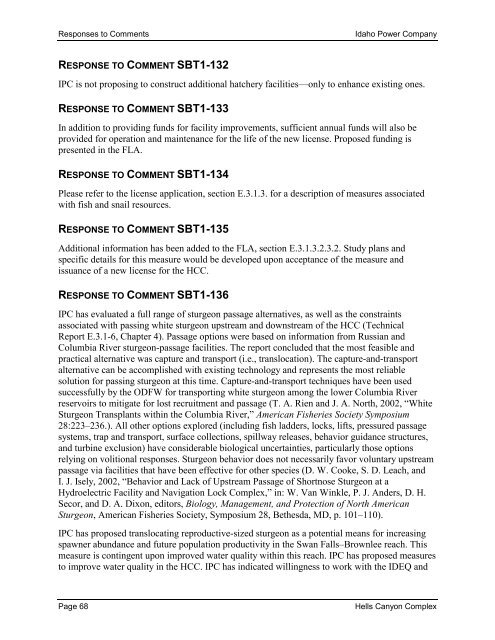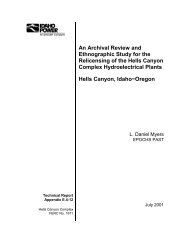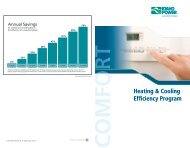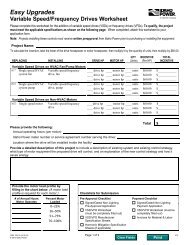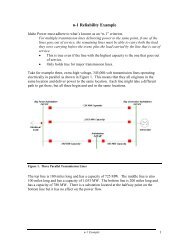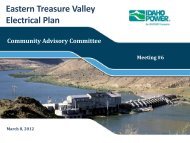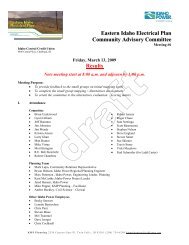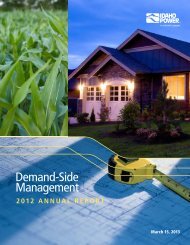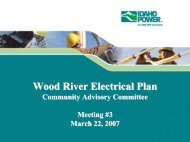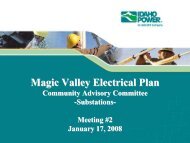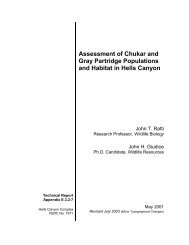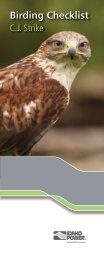Shoshone-Bannock Tribes - Idaho Power
Shoshone-Bannock Tribes - Idaho Power
Shoshone-Bannock Tribes - Idaho Power
You also want an ePaper? Increase the reach of your titles
YUMPU automatically turns print PDFs into web optimized ePapers that Google loves.
Responses to Comments<strong>Idaho</strong> <strong>Power</strong> CompanyRESPONSE TO COMMENT SBT1-132IPC is not proposing to construct additional hatchery facilities—only to enhance existing ones.RESPONSE TO COMMENT SBT1-133In addition to providing funds for facility improvements, sufficient annual funds will also beprovided for operation and maintenance for the life of the new license. Proposed funding ispresented in the FLA.RESPONSE TO COMMENT SBT1-134Please refer to the license application, section E.3.1.3. for a description of measures associatedwith fish and snail resources.RESPONSE TO COMMENT SBT1-135Additional information has been added to the FLA, section E.3.1.3.2.3.2. Study plans andspecific details for this measure would be developed upon acceptance of the measure andissuance of a new license for the HCC.RESPONSE TO COMMENT SBT1-136IPC has evaluated a full range of sturgeon passage alternatives, as well as the constraintsassociated with passing white sturgeon upstream and downstream of the HCC (TechnicalReport E.3.1-6, Chapter 4). Passage options were based on information from Russian andColumbia River sturgeon-passage facilities. The report concluded that the most feasible andpractical alternative was capture and transport (i.e., translocation). The capture-and-transportalternative can be accomplished with existing technology and represents the most reliablesolution for passing sturgeon at this time. Capture-and-transport techniques have been usedsuccessfully by the ODFW for transporting white sturgeon among the lower Columbia Riverreservoirs to mitigate for lost recruitment and passage (T. A. Rien and J. A. North, 2002, “WhiteSturgeon Transplants within the Columbia River,” American Fisheries Society Symposium28:223–236.). All other options explored (including fish ladders, locks, lifts, pressured passagesystems, trap and transport, surface collections, spillway releases, behavior guidance structures,and turbine exclusion) have considerable biological uncertainties, particularly those optionsrelying on volitional responses. Sturgeon behavior does not necessarily favor voluntary upstreampassage via facilities that have been effective for other species (D. W. Cooke, S. D. Leach, andI. J. Isely, 2002, “Behavior and Lack of Upstream Passage of Shortnose Sturgeon at aHydroelectric Facility and Navigation Lock Complex,” in: W. Van Winkle, P. J. Anders, D. H.Secor, and D. A. Dixon, editors, Biology, Management, and Protection of North AmericanSturgeon, American Fisheries Society, Symposium 28, Bethesda, MD, p. 101–110).IPC has proposed translocating reproductive-sized sturgeon as a potential means for increasingspawner abundance and future population productivity in the Swan Falls–Brownlee reach. Thismeasure is contingent upon improved water quality within this reach. IPC has proposed measuresto improve water quality in the HCC. IPC has indicated willingness to work with the IDEQ andPage 68Hells Canyon Complex


